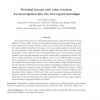Free Online Productivity Tools
i2Speak
i2Symbol
i2OCR
iTex2Img
iWeb2Print
iWeb2Shot
i2Type
iPdf2Split
iPdf2Merge
i2Bopomofo
i2Arabic
i2Style
i2Image
i2PDF
iLatex2Rtf
Sci2ools
EOR
2010
2010
Residual income and value creation: An investigation into the lost-capital paradigm
This paper presents a new way of measuring residual income, originally introduced by Magni (2000a,b,c, 2001a,b, 2003). Contrary to the standard residual income, the capital charge is equal to the capital lost by investors. The lost capital may be viewed as (a) the foregone capital, (b) the capital implicitly infused into the business, (c) the outstanding capital of a shadow project, (d) the claimholders' credit. Relations of the lost capital with book values and market values are studied, as well as relations of the lost-capital residual income with the classical standard paradigm; many appealing properties are derived, among which an aggregation property. Different concepts and results, provided by different authors in such different fields as economic theory, management accounting and corporate finance, are considered: O'Hanlon and Peasnell's (2002) unrecovered capital and Excess Value Created; Ohlson's (2005) Abnormal Earnings Growth; O'Byrne's (1997) ...
| Added | 10 Dec 2010 |
| Updated | 10 Dec 2010 |
| Type | Journal |
| Year | 2010 |
| Where | EOR |
| Authors | Carlo Alberto Magni |
Comments (0)

